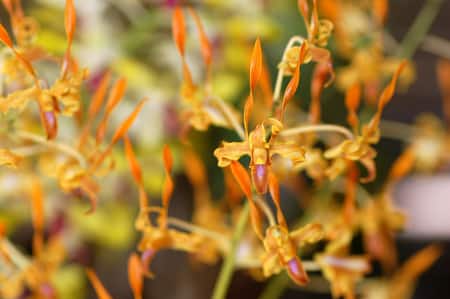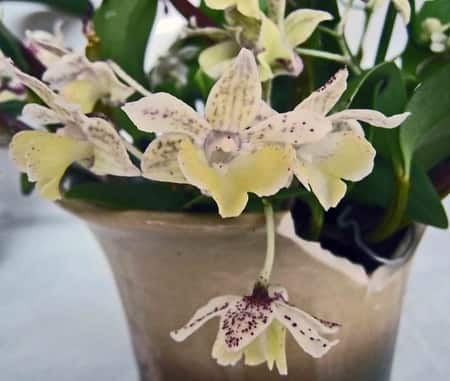Shriveled canes on a Dendrobium can cause certain discomfort. Why are they there? Should I cut them? Will they induce more flowers if cut? Are they a sign of dehydration? When your Dendrobium orchid shows signs of shriveled canes, you have several options. The most important is to know what caused the pseudobulb to wrinkle, and go from there.
What are the possible causes of shriveled Dendrobium canes?Dendrobium canes will shrivel due to the end of a normal life cycle, after blossoming has occurred, lack of water or nutrients, and an infection of some kind. These wrinkled canes are to be expected in most of the cases, but you have to be sure which one. Let’s look at them one by one.
Possible Causes for Dendrobium Canes to Shrivel
| End of the orchid’s life cycle | No Action Required Cut Canes if Dead |
| Right after Blooming | No Action required Leave Canes on Plant |
| Lack of Water | Water Twice Weekly Check Roots and Repot |
| Infection or Pests | Check for Insects Use a Pesticide or Insecticide |
1) Normal Dendrobium Shriveled Canes
Dendrobium orchids undergo a year’s cycle of rest (called dormancy), producing new roots, sprouting new leaves, and finally producing buds. It’s a good idea to keep a calendar on the first year of orchid growing so you’ll know what to expect each month/season for that particular orchid. For example, not all dendrobiums have a rest period—den-phals don’t.
Independent of having a strict dormant cycle, every year your Dendrobium will repeat the same cycle for its species. Even if the orchid has undergone some serious and stressful situations, the cycle maintains. In that case, it might not bloom but root and leaf growth should still be on par.

In this normal annual cycle, the flowers shall wilt then die. It’s part of life. After the flowers drop, the canes will start to shrink in diameter and slightly wrinkle, caving into themselves.
They have used their energy to produce beautiful blossoms and their nutrient supply is low. The grooves in the cane should NOT be very deep, nor visibly pronounced. If they are, then your orchid is dehydrated.
This is the time when they enter a winter’s rest period (remember: not all Dendrobiums have a rest period). In any case, you have nothing to worry about.
Just let your orchid do its thing.
2 + 3) Dead Dendrobium Canes Shrivel Naturally
Dendrobium canes will shrivel naturally both at the end of their life and at the end of each flowering season. That is why I doubled up on this point with number 2 and 3, since it’s essentially the same thing. The only difference is one is permanent and progressive, while the other is not.
In the next year’s cycle, the old Dendrobium canes can still produce buds and blossom. They shouldn’t be cut off or disposed of. Even when they don’t bloom, they still provide nutrients, water, and energy to keep the new growth alive.
After a few years, all the energy has been depleted of the old cane and now there is nothing left but dry, paper-like stalks. These eye-sore pseudobulbs do nothing for the orchid except provide possible entrances for bugs, pests, and insects.
These dead, shriveled Dendrobium canes should be cut off.
If you are in doubt of whether the cane is dead, cut the furthest part of the cane. If the middle is yellowish-brown, it’s dead. Keep cutting closer to the rhizome until speckles of green start to appear—stop! You’ve cut too far. There shouldn’t be green anywhere in the dead pseudobulb/cane.
4) Indications of Dehydration in Shriveled Dendrobiums
If your Dendrobium cane is shrinking and shriveled and the flower is about to bloom, in bloom, or any other time except rest, then this may be a sign that it’s not getting enough water and is dehydrated. The wrinkles or grooves will de deeper than a normal dormancy cycle and they don’t plump back up ever.
Your orchid will also display other signs that it is dehydrated. The leaves will slightly wilt, turning leathery and cracked. The leaves also droop, as if they were going through depression with no cause to live for. They just dangle, with no resilience of resistance to being folded.
Increase both watering duration and frequency for a week. The deep groves shall not disappear or push back out to plumpness, but you’ll be saving your orchid from lack of water. Once a Dendrobium orchid has withered canes, it won’t ever go back to completely normal. The withered effects are permanent. The expectation is to plump out slightly, yet the deep grooves will remain.
Supplying extra water is advised only if you know that your orchid has a decent root system. There is no point in watering if your Dendrobium has no healthy roots to soak up the water.
If the leaves appear to have perked up after that first week of watering, then you’re good. If not, unpot the orchid and take a look at the roots. The shriveled Dendrobium cane may be a cause of insufficient roots that just don’t provide the water they need from the start.
5) Infection or Bacteria in Shriveled Dendrobium Canes
The last reason a Dendrobium cane shrivels is due to outside influence. This can be in form of bacteria, fungus, pests, or insects.
A bacterial infection that isn’t treated properly can kill the cane in all of 2 weeks.
Root rot, when not cared for, will also have the same affect.

Dendrobium Micro Chip
Some insect burrow through the plant tissue and even though you don’t see visible signs on the exterior of the cane, they are inside feasting on a highly nutritional buffet. The otherwise healthy orchid starts to wilt. This is visible when only one of the canes withers, usually the youngest cane since the plant tissue is softer, while all the rest are plump.
In this article about pesticides and insecticides, you’ll get an overview of the most common pests that attack orchids and their remedies. Some of the solutions I presented in this article are homemade and organic, since pesticides can harm the orchid.
There are some other common questions about Dendrobium Canes that also are closely related to this article, but weren’t the reason they shriveled. So, I didn’t want to include in the main article. I listed them below.
If you have more questions, please comment in the section below.
Should you Cut the Shriveled Dendrobium Canes?
After a few years, there might be a quite substantive amount of old, paper-like canes hanging off your orchid. These darker canes with a yellowish-brown color should only be removed if you guarantee for a fact, they are dead. If there is any chance that they are still alive, why remove them? After all, they are supplying nutrients to the new growth.
Does Cutting Canes Promote More Flower Growth?
Cutting canes from spent Dendrobiums is not ideal. This idea appeared first with phalaenopsis orchids, where cutting the flower spike after blossoming would induce more flowers. Yet these are two separate genera and anatomical structures; what applies to one can hinder the other.
For starters, a flower spike is not the same thing as a cane. When you cut off a cane, you are essentially destroying the nutrient storage of the orchid. Its life storage unit has just been removed. For a flower spike, it will grow back naturally, inducing more blossoms; a Dendrobium cane will not.
In second place, if you cut off a shriveled Dendrobium cane thinking that will induce more flowers, you just cut off the place where the flowers would be induced. Phalaenopsis orchids don’t produce flower spikes from pseudobulbs because they don’t have pseudobulbs. They sprout from the stem of the orchid, thus are safe to cut off. Dendrobium Phalaenopsis orchids will imitate this same pattern of growth, but other Dendrobiums grow closer to the cane. Make sure you double-check what you are about to cut.
Older canes can still produce buds and flowers, so don’t cut them thinking this will induce more growth. It won’t.
Propagation Through Cutting Dendrobium Canes
Older, wrinkled Dendrobium canes may be used to propagate new orchids. Some growers who cut old canes and with proper hydration and care, this cane shall use its energy to produce a keiki on the side. Once the keikis has a decent root system, it can be potted.
This method only works if there are sufficient nutrients in the old cane. In most cases, if the cane is so shriveled that you felt the necessity to cut it off, then it probably won’t hold up to producing a healthy keiki very well. If you want to try this method, then pick a cane that isn’t terribly old or wrinkled.If you want to read more about Dendrobium care, these articles are a good place to start.
First you need to identify what species of Dendrobium you have. Since there are over 1,400 species, divided into five groups (or six, depending on who you read) there are several different growing requirements. So check this article which is an overview of each specific Dendrobium group.
If you aren’t sure about the Dendrobium roots and how to water them, this article about Dendrobium roots will show you what’s normal and what is not.
In the last article, which isn’t specific to Dendrobiums but all orchids in general, will give you several ideas on how to water. If the problem of the shriveled Dendrobium cane was lack of water, this article about watering orchids is an excellent reference to follow.
As for articles not written by me, this article is a humorous yet informative take on growing Dendrobiums written by Sonia Uyterhoeven and published in the Plant Talk Inside the New York Botanical Garden. I like the way she relates to Dendrobiums because I felt the same way she did at first. It is well worth the read.
is a humorous yet informative take on growing Dendrobiums written by Sonia Uyterhoeven and published in the Plant Talk Inside the New York Botanical Garden. I like the way she relates to Dendrobiums because I felt the same way she did at first. It is well worth the read.
Don’t Stop Learning!
If you want to be included in more information and get a 14-page fertilization guide, please sign up for my newsletter. I don’t spam, but send emails out bi-monthly with some curious topics of interest. If you want more information, click here to go to a specific page on this website where I explain it more in detail.

Also, if you are looking for an orchid journal to keep your notes specifically about orchid care, check out my 2 solutions for that on this page. If note-keeping isn’t your thing, then there is a free excel spreadsheet that you can download. Click here for more information on how to do that.
If you subscribe to my newsletter, I will send you a 14-page guide on the main tips of orchid fertilizer. It is downloadable and you can print it out on your computer. I designed the guide to double up as a coloring book, just to make it fun.
Happy Cultivating!

